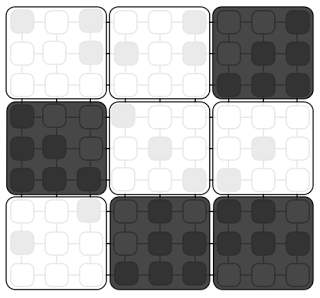The definition of Ising model
Some of the following text come from here
It is a simple model for a magnet where spins can point up or down, and like to align with their neighbours through a coupling constant J.

Energy describes the interactions between spins. The total energy of the system decreases for 1 unit if two connected spins have the same direction, and increases for 1 unit otherwise. We write the energy of the system as
in which J is a constant and the item following J sums over all connected pairs of spins. H represents the strength of the magnet field outside the system. The energy decreases 1 unit for every spin that has the same direction with the outside maget field.
Let’s see a concrete example, in which three spins are connected:

The system has 2^3 = 8 different states, including
We can calculate the energy for each of these states as
and find that +1,+1,+1 is the state with minimum enegry.
Monte Carlo simulation
Different from agent-based models (ABM), in Ising model simulation we do not give rules for individual agents, but evolve the system according to some system-level statistics.
In particular, for each iteration, the program will randomly flip one spin. The new state s’ replaces old state s with a probability miu defined as
In other words, the old state will be remained with probability 1-miu. According to this rule, the system will have the following probability of state distribution
which is the famous Boltzmann distribution. k is the Boltzman constant = 1.3806488*10^{23}, and Z is the normalization factor
In statistical physics, Z is also called the partition function of system. It is the function of temperature T and maget field strength H.
See the following python code cited from here:
#!/usr/bin/env python
"""
Monte Carlo simulation of the 2D Ising model
"""
from scipy import *
from scipy import weave
from pylab import *
Nitt = 1000000 # total number of Monte Carlo steps
N = 10 # linear dimension of the lattice, lattice-size= N x N
warm = 1000 # Number of warmup steps
measure=100 # How often to take a measurement
def CEnergy(latt):
"Energy of a 2D Ising lattice at particular configuration"
Ene = 0
for i in range(len(latt)):
for j in range(len(latt)):
S = latt[i,j]
WF = latt[(i+1)%N, j] + latt[i,(j+1)%N] + latt[(i-1)%N,j] + latt[i,(j-1)%N]
Ene += -WF*S # Each neighbor gives energy 1.0
return Ene/2. # Each par counted twice
def RandomL(N):
"Radom lattice, corresponding to infinite temerature"
latt = zeros((N,N), dtype=int)
for i in range(N):
for j in range(N):
latt[i,j] = sign(2*rand()-1)
return latt
def SamplePython(Nitt, latt, PW):
"Monte Carlo sampling for the Ising model in Pythons"
Ene = CEnergy(latt) # Starting energy
Mn=sum(latt) # Starting magnetization
Naver=0 # Measurements
Eaver=0.0
Maver=0.0
N2 = N*N
for itt in range(Nitt):
t = int(rand()*N2)
(i,j) = (t % N, t/N)
S = latt[i,j]
WF = latt[(i+1)%N, j] + latt[i,(j+1)%N] + latt[(i-1)%N,j] + latt[i,(j-1)%N]
P = PW[4+S*WF]
if P>rand(): # flip the spin
latt[i,j] = -S
Ene += 2*S*WF
Mn -= 2*S
if itt>warm and itt%measure==0:
Naver += 1
Eaver += Ene
Maver += Mn
return (Maver/Naver, Eaver/Naver)
def SampleCPP(Nitt, latt, PW, T):
"The same Monte Carlo sampling in C++"
Ene = float(CEnergy(latt)) # Starting energy
Mn = float(sum(latt)) # Starting magnetization
# Measurements
aver = zeros(5,dtype=float) # contains: [Naver, Eaver, Maver]
code="""
using namespace std;
int N2 = N*N;
for (int itt=0; itt<Nitt; itt++){
int t = static_cast<int>(drand48()*N2);
int i = t % N;
int j = t / N;
int S = latt(i,j);
int WF = latt((i+1)%N, j) + latt(i,(j+1)%N) + latt((i-1+N)%N,j) + latt(i,(j-1+N)%N);
double P = PW(4+S*WF);
if (P > drand48()){ // flip the spin
latt(i,j) = -S;
Ene += 2*S*WF;
Mn -= 2*S;
}
if (itt>warm && itt%measure==0){
aver(0) += 1;
aver(1) += Ene;
aver(2) += Mn;
aver(3) += Ene*Ene;
aver(4) += Mn*Mn;
}
}
"""
weave.inline(code, ['Nitt','latt','N','PW','Ene','Mn','warm', 'measure', 'aver'],
type_converters=weave.converters.blitz, compiler = 'gcc')
aE = aver[1]/aver[0]
aM = aver[2]/aver[0]
cv = (aver[3]/aver[0]-(aver[1]/aver[0])**2)/T**2
chi = (aver[4]/aver[0]-(aver[2]/aver[0])**2)/T
return (aM, aE, cv, chi)
if __name__ == '__main__':
latt = RandomL(N)
PW = zeros(9, dtype=float)
wT = linspace(4,0.5,100)
wMag=[]
wEne=[]
wCv=[]
wChi=[]
for T in wT:
# Precomputed exponents
PW[4+4] = exp(-4.*2/T)
PW[4+2] = exp(-2.*2/T)
PW[4+0] = exp(0.*2/T)
PW[4-2] = exp( 2.*2/T)
PW[4-4] = exp( 4.*2/T)
#(maver, eaver) = SamplePython(Nitt, latt, PW)
(aM, aE, cv, chi) = SampleCPP(Nitt, latt, PW, T)
wMag.append( aM/(N*N) )
wEne.append( aE/(N*N) )
wCv.append( cv/(N*N) )
wChi.append( chi/(N*N) )
print T, aM/(N*N), aE/(N*N), cv/(N*N), chi/(N*N)
plot(wT, wEne, label='E(T)')
plot(wT, wCv, label='cv(T)')
plot(wT, wMag, label='M(T)')
xlabel('T')
legend(loc='best')
show()
plot(wT, wChi, label='chi(T)')
xlabel('T')
legend(loc='best')
show()
The following figure shows the result of simulation on a larger grid (than the one in the code)

The first row shows T>Tc, the second row shows T~Tc, and the third row shows T<Tc.
Renormalization group
See the following figures cited from here:




There is a striking feature of Ising model. When T ~ Tc, the strcuture of the grid is invariant of scale.
As shown by this video, when the temperature approaches the cirtical temperature, the information (of the ratio between the number of white and black spins) can not be compressed.